top of page
Interned by the British
Description
Britain's famous slogan regarding its global presence was: "The Sun Never Sets On The British Empire".
It is also fair to state "The Sun Never Set on Jews Imprisoned by the British Empire".
Between 1933 and 1939, tens of thousands of Europeans fled to safer countries. As many as 80,000, mostly Jews, reached England. There was sympathy for refugees but also anxiety about foreigners who spoke the language of the German enemy. In May 1940 all aliens were interned, in hotels, resorts, facilities, even stadiums. Beyond England proper, many were deported to Commonwealth locations, including the Isles of Man and Wight, Canada, Australia, New Zealand, India, and Islands in the Caribbean Sea.
Jews who were caught trying to enter Palestine illegally were interned in camps in Palestine, Cyprus, and Mauritius. Refugees were housed in Egypt and Syria.
The underground organizations of 'Irgun' and 'Lehi' continued to harass and frustrate Mandate authorities. Apprehended members were interned/imprisoned in facilities in Palestine. As they became difficult to contain, they were shipped to camps in Africa.
Mandate authorities were also wary of the (Christian) German Templers who had settled in Palestine, unsure of their loyalties. Their settlements were turned into internment camps, and many were deported.
 Website image |  World MapBritish internment around the world. |  Kitchener CampA camp for Jewish men aged 18-40 was set up in an abandoned army camp in Richborough. Technical & agricultural training was offered. It soon held 4,000 internees. They were deported. Josef Finkelstein writes his sister in New York asking for help with ID papers. He ended up in camp A in Canada. |
|---|---|---|
 Kitchener Camp.InboundThis envelope was mailed from Berlin TO camp Kitchener, in Kent county England. April 20, 1939 was Hitler's 50th biirthday. This must have been one of the first letters to reach this camp, once the family in Berlin learned its address. |  Kichener Camp.map |  Huyton CampNear Liverpool, this camp confined people of German, Austrian, and Italian birth. Some were Nazi supporters while many were Jewish or anti-fascist. among them were numerous artists and scholars. Conditions were poor. They were freed between 1942- 45. Walter Fast writes to his parents in Tel Aviv. |
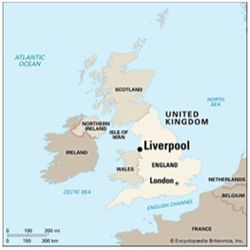 Liverpool, Huyten Map |  Peveril CampThe Isle of Man, located in the Irish Sea between England and Ireland, had 6 camps - all fenced-off hotels holding various nationalities. Peveril was in the town of Peel. Mr. Lipmann writes to relatives in Cleveland Ohio. The camp also held British Nazi sympathizers. |  Mooragh CampThe 1st camp to open on the Isle of Man was at Mooragh in Ramsey. 30 small hotels & boarding houses were enclosed with barbed wire. The various units included recreation, and provided workshops to develop professions. Employment outside the camp was eventually permitted. The camp printed a newspaper, booklets, and this posttcard for Chanukah 1940. |
 Rushen CampThe camp at Rushen was located in 2 holiday resorts on a southern peninsula. 4000 women were held with children, mostly from Germany and Austria: single women in Port Erin and mothers with family in Port St. Mary. There were cultural & social activities, and schools for the children. Most of the Jewish women were released in 1941, but some 130 family members were held until well after the war, in September 1945. Mailed to Haifa, Palestine. |  Port ErinInge Moller, a single women in Camp Erin, writes to Stanley Parsons in Bristol England on 9 January 1942. The letter sheet has been stamped 'Women's Internment Camp, 10 January 1942, Isle Of Man'. |  Port Erin.message"...I must make a serious effort towards possible release. The war will last many years and i ought to (if possible) throw off the stigma of 'Enemy Alien'......My 25 lines are up...". |
 Onchan.coverL. Wilmersdoerfer in Onchan Internment Camp writes to London in 1940. Onchan Camp, on the north end of Douglas Bay, opened 11 June 1940. 60 houses each contained 8+ rooms. The hundreds of internees included artists, writers, scientists, teachers, lawyers engineers physicians etc. They set up a university and published a camp newspaper. |  Onchan CampThey somehow issued their own camp token coinage in October 1940, in 3 denominations: 1/2, 1, and 6 pence. A year later these were replaced by paper money tokens. |  Onchan CurrencyInternees worked at various trades and were paid in this token currency. The denominations were Half-Crown, 5 shillings, and 10 shillings. The image is of the 'Tower of Refuge' located nearby in Douglas Bay. They were soon replaced by generic Home Office Civilian Internment notes. |
 Onchan Map |  Canada.Camps Map |  Canada.Camp AInternees from England were deported to Canada in July 1940. Joseph Finkelstein had been in Kitdchener, was now in Camp 'A' located in Farnham, Quebec. It operated from October 1940 until January 1942. Its 445 internees were later transferred to Camp 'N'. Finkeslstein writes to sister Susie in New York City in December 1940. Censored by Canada and then the US. Farnham Quebec |
 Canada.Camp BCamp 'B' in Ripples, New Brunswick operated from 1940 - 45. Its first internees were transfers from camp 'T', including a large group of Orthodox Jews.. They had Kosher dining facilities and a Saturday synagogue. Mandatory labor involved chopping trees in the forest. Heinrich Hayek writes to his uncle in New York City. Rabbinical and university students secretly pursued their studies. |  Canada.Camp IIle Aux Noir, Quebec was the site ofCamp 'I'. This internee camp became a 'refugee' camp. They were employed in light manufacturing, producing camouflage nests for the war effort, and farming. The camp closed in mid-1943. |  Camp I.letter.a12/26/41. Eric writes to friend Alex. "I'm very eager to get in touch with you again...I have adjusted myself ompletely and my life goes alon prearranged line...". |
 Camp I.letter continued"...beginning next semester I will be going to school in the daytime and work only a few hours every day. The army doesn't want me until I am 20 so I have 1 more year to go yet." |  Canada.Camp LMailed from Zurich, Switzerland to Camp 'L' in Cove Fields Quebec. Opened July 13, 1940 to temporarily accomodate 743 internees from England, 60% were Jewish with others who were pro-Nazi. Actually closed on Otober 20th with internees moved to camps A, N, or T; the Jews mostly went to N. By the time this was mailed, January '41, the camp was closed. If the red mark is a 'B', perhaps it was forwarded to that camp. |  Canada.Camp NJulius Kornspan wites to his uncle in San Francisco from camp 'N', which was at Newington near Sherbrooke in southern Quebec. It operated June 1941 - November 1942 holding internees who arrived on the HMS Ettrick & HMS Sobieski. "Thank you for the letter and money order...my poor father is still in the German concentration camp Buchenwald... I do not make any complaints...". |
 Canada.Camp QHeinz Baer is in Camp Q, at Monteith in the southern part of Ontario province. It operated from 1940 - 46. This is his 4th camp, starting with Dachau! "...Everything here luxury in comparison with Dachau." Mailed 10 November 1940. When camp Identification changed to numbers, Camp Q became Camp 23. |  Carribean.Gibraltercamp JamaicaOriginally intended to temporarily house wartorn citizens of Gibralter in October 1940, Jewish refugees began to arrive in1942. Communal activities, schools, shops, hospital, synagogue, and kosher kitchen. They had work, books, newspapers, radios, and sufficient food. Eventually numbered over 3,000. Mailed in Argentina 4 February 1943. |  Jamaica.map |
 Bonaire CampBonaire is a Dutch-owned island off the coast of Veneuela. In May 1940, 461 German & Austrian people were brought here. Some were captured German sailors and other supporters. Also included were civilians who had escaped Nazi Germany! This was not the only time Jews found themselves locked up with hostile men from their own country. mailed at Bonaire 12 October 1940 to New York City. | 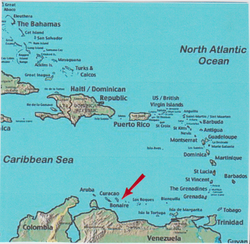 Bonaire.map | 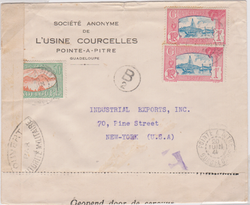 GuadeloupeEscaping Dutch Jews tried to land at French-owned Guadeloupe but were refused. The ship continued to Curacao and the Jews ended up in Bonaire. This letter was mailed from Guadeloupe to 'Industrial Exports' in New York City, an office maintained by the Haganah to help communicate with Jewish refugees and immigrants during the war. |
 Guadaloupe Bonair.map |  Trinidad Internment CampThis camp was located in Trinidad's capital city, Port-of-Spain. The British interned some 600 'enemy alien' Jews, along with captured German & Italian seamen. Barbed wire fence, sentry towers, searchlights. Children were allowed to go to school. Jews were released in 1943. Most left the island. Letter mailed 28 March 1941 to a relative in Buenos Aires. |  Trinidad Internment CampThis letter was mailed 5 November 1940 to New York. The postmark reads 'Port of Spain'. The British censor stamped his seal on the back. |
 Trinidad.map |  Australia.Camp Hay.7Camp Hay was located 750 kilometers west of Sydney, in the Australian state of New South Wales. Towers, barracks, harsh climate. Jews were held in camps 7 & 8. Internees arrived 27 August 1940. Organized activities and a university. 200 Chassidim set up a Yeshiva and kosher kitchen. 1500 who volunteered for war service were released. Others were transferred to Camp Tatura. Stamped 'Prisoner of War Service by the censor. |  Australia.Camp Hay.8This letter was mailed locally, (to the Zionist Federation of Australia) so no stamp was required. In its place is stamped 'Prisoners of War, CS Thane Lt. Col. Comdt Hay'. Walter Nathan was interned in camp #8. |
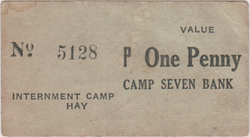 Australia.Camp Hay.TokenCamp Hay internees designed and produced camp banknotes for use among themselves. They were colorful but controversial so were withdrawn & destroyed within a few months. Some very plain small denominations like this one were produced in denominations of 1 penny on greenish paper and 3 pence on cream yellow paper. Some are signed 'R. Stahl' who was a bank manager. The backs are blank. |  Camp Hay.Map |  Australia.Camp TaturaCamp Tatura was located 176 kilometers north of Melbourne in the Australian state of Victoria. Camps were purposely located away from cities. 3 camps held POWs while 4 others were for civilians. This letter mailed in England 23 October 1942 was sent to camp #2 which held about 1000 German & Italian males. Jews were brought here when Camp Hay closed in 1941. Climate hot and dusty. Charities donated sports & music equipment & typewriters. Internees set up a 'University'. |
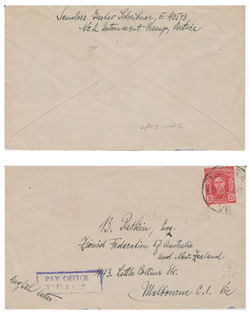 Australia.From TaturaMailed at Tatura to the Zionist office in Melbourne. Gustave Scheibner was interned in camp 2. Sent through the regular mail with NO censorship and WITH a stamp ! Addressee B(enzion) Patkin was a prominent Australian Zionist. He later facilitated immigration to Israel for 150 internees from the Dunera. The camp was dismantled in 1946. |  Tatura.map | 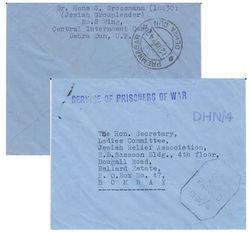 India.DehraDun CampSeveral camps were set up in India for enemy aliens, POWs, and Jewish refugees. DehraDun is in northwest India. Hans Grossman, Jewish groupleader in the camp sent this letter on 12 May 1942 to the Jewish Releif Association in bombay. Censored and stamped 'Service of Prisoners of War'. |
 Dehra Dun.Map |  India.map |  Satara CampSatara is located on the southwest coast of India. Foreign Jews were interned here from 1940 to 1946. Life was not harsh but movement and livlihood were limited. This envelope also went to the Jewish Relief Association in Bombay, specifically to the Ladies Committee. The censor mark reads 'Internment Camp and Parole Centre Satara', and is signed. |
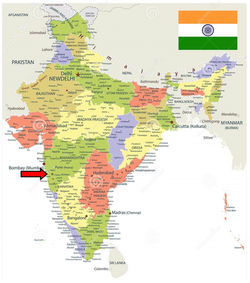 India.map |  Mauritius.Camp Beau BassinIn Nov 1940 3 ships carrying over 3600 'illegal' Jewish immigrants from Germany, Austria, and Czechoslovakia arrived in Haifa. 1580 were deported to the tropical island Mauritius, arriving Dec 29. Beau Bassin was a former criminal prison camp. Poor conditions and a typhus epidemic soon killed 100. But treatment was proper. Marriages and births took place. On August 26, 1945, 1300 were freed and brought back to Haifa. Mailed 17 August 1944 to Tel Aviv. |  Mauritius.Map |
 Palestine.Atlit.RomaniaAnyone trying to avoid the immigrant quota was liable to be deported or interned. In 1939 Atlit Camp was set up, south of Haifa, with barracks, fences, & watchtower. Illegals were kept here until deported. It closed in 1942 but re-opened in 1945 to deal with the flood of Holocaust survivors. Detainees were released when the British left in May 1948. Today it is a National Heritage Site and museum. |  Atlit.MatzahHungarian Tibor Tanenbaum is held in 'Athlit Clearance Camp'. Leaders of the Chareidi Hungarian Kollel Shomre Hachomot in Jerusalem address him in Hebrew as a Torah scholar. They are unable to arrange his release. 'We intend to send you Matzos for the coming Passover, if G-d forbid you are still there'. Mailed 2 weeks before Passover but not processed by the Criminal Branch headquarters in Jerusalem until July 8th (1940) ! |  Atlit.Meal TicketThis cardboard token was a meal ticket given out to internees. It is for supper and was distributed by the Jewish Agency. It identifies the place as 'Camp for Illegals Atlit'. The Jewish Agency helped the 'illegals' in the Cyprus camps and in Atlit. |
 Atlit.Map | 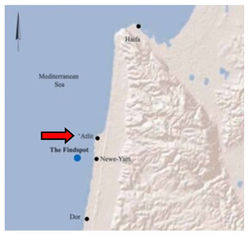 Atlit.Map | 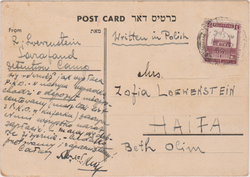 Palestine.Sarafand CampThe ship Skaria organized by Beitar activists in Europe arrived in Haifa 14 February 1940 carrying 2300 refugees. 300 women & children were released but 1600 were taken to Atlit and 400 to Sarafand in the center of the country. It was the largest British military base in the ME with a prison & a Detention Camp. They were released after 6 months. '...We have to talk to a lawyer and maybe we will be released from camp". 13 March 1940, in Polish except for the last word in Hebrew - 'Lehitra'ot'. |
 Sarafand Camp.map |  Cyprus.Jewish immigration to Palestine was discouraged by intercepting their vessels & interning them in Cyprus. 39 such ships were caught in 'Operation Igloo'. At peak, there were 9 camps in Cyprus at 2 sites. Caraolos, a tent camp north of Famagusta, and Dekhelia, with tin huts outside of Larnaca. They operated August 1946 to January 1949, holding about 51,000 people. |  Cyprus.Camp 67Mailed from Haifa on 1 June 1947 to Camp #67. The address is instructive. 'Ship Moledet' identifies the ship this person was taken from. (Came from Italy, held 1563 refugees; deported to Cyprus on 29 March 1947). 'Kibuc Haoved 17' indicates affiliation with the ideological youth group Ha'oved/Dror which was labor/socialist oriented. Internees organized along these party lines. |
 Cyprus.InternalThis envelope was mailed locally among the internees. The 'stamp' is a JNF label; the cancellation reads 'Mazkirut Mahane 69 (Secretariat Camp 69). It is addressed to Shulamit Geller, Winter Camp, Cyprus. The 7 winter camps offered more shelter. |  Cyprus.Canteen ScripThese notes were printed in Jerusalem for use by internees in the canteens. The American Jewish Joint Distribution Committee was permitted to supplement the meager services of the British. Their relief program included food, clothing, medical care, cultural & educational activities and vocational training. |  Cyprus.NewsletterNewsletter printed in Cyprus, dated 31 January 1949. '48' likely the issue number. Titled 'Shurot'. Top headline: Third Group Makes Aliyah'. Below it mentions that the 1500 man group brings the total to half of the internees - the rest remain in camps. News about the U.N. vote on Israel and Israeli politics. |
 Cyprus.map |  Egypt.MERRA.Yugoslav campAmong thousands of refugees escaping WWII in the Balkans were some who reached the Palestine area. Britain set up the Middle East Relief & Refugee Administration in 1942, establishing camps in Egypt, Gaza, and Syria in 1942, accommodating over 40,000 refugees. At the El Shatt camp at the southern end of the Suez Canal, thousands of Yugoslavian refugees were settled in tents, in the baking sands. Disbanded in 1946. This mailed in September 1944. |  El Shatt area.map |
 Syria.MERRA camp.AleppoGreek refugees arrived in Aleppo, Syria in 1944. Conditions were difficult, food was sparse, but activities were organized and refugees were encouraged to work. The camp came under the U.N. (UNRRA). Stella Versano writes to Albert Franco at the Immigrant House in Tel Aviv, on 8 August 1944. |  Syria.Aleppo.letter8 August 1944. Written in French to her brother. Her city of origin has been cut (by the censor) from the letter. "Surely you are aware of the terrible events in Salonica and Athens against the Jews .... Our sister Sarah, her husband & daughter were stopped by the Germans and deported to Poland... Every day we look forward to travelling to Palestine. We hope to meet you ". |  Syria.Map |
 Palestine.Jerusalem Central PrisonBritain made Jerusalem's Russian Compound their headquarters. Government offices, police headquarrters, courts, and the Jerusalem Central Prison. Here members of the Haganah, Palmach, and the Jewish 'underground groups' Etzel and Lehi were held locally. Mailed from Tel Aviv 2 January 194?. |  Jerusalem.Camp # 1Camps were numbered and/or lettered. These can be confused with other numbered camps in which Christian German Templars were interned during WWII. This envelope from 'Internment Camp #1' could be from Jerusalem. But all internee mail went through the Jerusalem police office so it's unclear. It was sent postage -free and censored by the British. |  Latrun.Camp AActivists in the Irgun (Etzl) were held in prisons/camps in Jerusalem, Akko, Atlit, Latrun,and Bethlehem. This envelope was mailed from 'Internment Camp Latrun A' 17 Sept 1947 to his lawyer in Jerusalem. Latrun overlooks the road between Jerusalem and Tel Aviv. |
 Latrun.Camp BSent TO Latrun Camp B (Bet), a major prison holding POWs, sympathizers, & Irgunists. Zionist leaders were rounded up and put here on 'Black Sabbath' 29 June 1946. The British had hanged 2 Irgunists and in response 2 British sergeants were killed. In fury and frustration the British imprisoned more leaders in August 1947. Among them was this addressee, Yisrael Rokeah, Mayor of Tel Aviv. Notice he is addressed as a 'VIP'. He was released after several weeks. |  Beit Lehem.Women's PrisonWomen activists were detained in a prison set aside for them in Bethlehem. This envelope is addressed to 'Sara Kehlach, Detainees (female) Camp Beit Lehem'. Also rubber-stamped 'matron/Women's Prison, Bethlehem'. Addressed to AIG CID (Assistant Inspector-General of the Criminal Investigation Department) Jerusalem, through which all mail was cleared. |  To Beit Lehem PrisonMailed 17 November 1944 from the women's prison. A building in Bethlehem had been used as a women's prison. In 1943 a house in the center of the city held female members of the underground. Here a stamp was used, though not usually required of internees.The women were not released until the British left the country in 1948. |
 To Beit Lehem wifeLEHI member Yitzhak Salonikio, interned in Latrun since March 1947, writes to his wife Loti who is interned in the women's camp in Bethlehem. Censored 28 November 1947. They were probably not released until the British left in May 1948. |  Beit Lehem.letter to wifeHis long letter is in Bulgarian and Hebrew. She doesn't know much Hebrew. He writes "...Let's keep our promise to write a little in Hebrew in each letter...I read The Count of Monte Christo and relate to his despair and his hope...". He also writes a few lines to the fellow internee who is teaching her Hebrew. |  Beit Lehem.letter Bulgarian |
 Map.Jerusalem, Latrun, Bethlehem |  Akko/Acre Central prisonThe Akko Citadel, an Ottoman army barracks and prison, became the British prison for rioting Arabs and later for Jews in the underground. When Mordechai Nemirovsky organized demonstrations against the White Paper which restricted Jewish immigration, he was held here. Mailed 7 May 1940. After Israel became a state, 'Namir' served as a member of Knesset and Mayor of Tel Aviv 1959-69. Return address reads 'Farm Labour Camp, Central Prison Camp Acre'. |  Mazra'a.GaliliA branch of the Akko prison was a camp in the Arab village of Mazra'a. Dozens of political internees, members of Etzel & Lehi, were held here. The camp was closed in December 1942 and the internees transferred to Latrun. This envelope was for official British business and was used twice. Cancellations are 16 April Jerusalem, 18 April Haifa, and 21 April Acre (Akko). Then probably driven to Mazra'a camp. Yitzchak Shamir was jailed here in Dec 1941, until he escaped. Note the name Henry Galili. |
 Mazra'a.'Henry Galili'There were 2 Henry Galilis. Dr. Henry Galili was a lawyer who established a travel agency. He facilitated immigration to Palestine for Europeans who couldn't obtain a legal cetificate by bribing the relevant officials. 15,000 came before it was shut down. A Revisionist, one Moshe Kriboshein, took the Galili name and organized immigration for some 18,000 refugees. The British arrested Etzel members including the real Dr. Henry Galili. Despite his protests, he was interned for 4 1/2 years. | 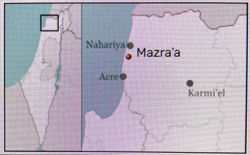 Mazraa.map |  Latrun.Galili.Camp 6?With others, Galili was transferred from Mazra'a to Latrun, where he received this envelope in January 1943. (He notes that it took 40 days to go from Jerusalem to Latrun - 27 kilometers.) The sender, a French military chaplain, is in 'Camp 6' which I haven't as yet identified. |
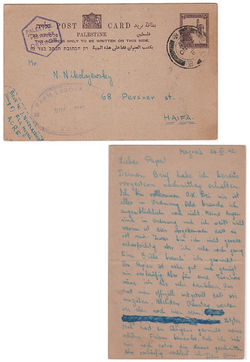 Mazra'a.Nikolayewsky'Ossi' Nikolajewsky writes to his Papa in Haifa, in German on 26 November 1942. His return address is Acre but specifically the F.L.C. (=Farm Labor Camp) at nearby Mazra'a. He calls it 'Camp 5' which is confusing because other letters call Mazra'a camp #1 (and they call Camp Wilhelmina near Jaffa camp #5). The British police numbering system is unclear. |  Latrun.NikolajewskyNow it's 19 November 1943 and 'Ossi' writes his Papa in Tel Aviv. His return address is now Latrun internment camp, but he identifies it as Camp 2. This is also confusing because other envelopes identify Camp 2 as Waldheim, where German Templers were held. Perhaps he meant Latrun B, which was one of Latrun's 2 camps. |  Rav Levin letterRabbi Aryeh Levin (1885-1969) was a legend of righteousness. He was called the 'Tzadik of Jerusalem' for his work with the poor and the sick. He took special interest in the Underground prisoners and visited them daily, giving encouragement and organizing prayers, earning the title 'Father of Prisoners'. This letter authorized him to also visit prisons outside Jerusalem. |
 Handbill.Prisoners Transfer to AfricaOn 19 Otober 1944 the British suddenly transferred 251 prisoners from Latrun to Sambel Camp near Asmara in Eritrea, Africa - due to fear of escape. It was named 'Operation Snowball'. This handbill cries out for them: "Remember the 251. If you go about business as usual, tomorrow it could be thousands!. Remember the shame of deportation." |  Asmara EritreaMailed from Haifa 10 April 1948 to Asmara, to a British officer stationed there. Eventually a total of 439 men, half of them Underground detainees, were deported. An estimated 60 % were Irgun, 30 % Lehi, and some neutral others. Conditions were decent but food was scarce. Due to escape attempts, they were transferred to Carthage in Sudan. |  Asmara.letter RE GetInternee Shlomo Trachtman writes to the Chief Rabbi of Jerusalem a heartbreaking letter asking him to summon his wife & act as his agent in handing her a 'Get' - bill of divorce. He has consulted with a rabbi & had the document written & signed by 2 witnesses. According to her letters, she is eager to receive it. Her address is included. And, could the rabbi please help him as he has been confined for 5 years and now has no-one. Dated Exile camp in Asmara 6 sivan 5606. |
 Asmara.the GetThis is the document of divorce, written in Camp Asmara. It conforms, with slight differences, to the standard traditional text. It is written carefully, but in cursive, not the square script of a scribe. High ascender & low descender letters are traditionally used to prevent changes to the text. The location is described as 'Internment camp in the barracks of Sambol adjacent to Asmara'. Dated Sunday 10 days in the month of Sivan year 5606. Signed by Shlomo ben Avraham Trachtman & 2 witnesses. |  Map.Asmara |  Carthago, SudanDetainees were moved to Cathargo Sudan for most of 1945. Conditions were worse, due to desert heat and lack of water. There was much educational activity. Meir Shamgar later became president of Israel's supreme Court and Yitzchak Shamir became Prime Minister of Israel! Abraham Igelsky writes to parents in Haifa 23 July 1945. "I'm innocent ...talk to people in power...it's been 17 months & nothing has been done...Write more often." But they were only allowed 2 letters a month. |
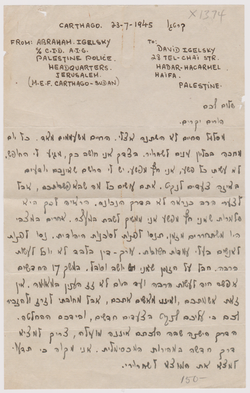 Carthago.letter.a |  Carthago.letter.b |  Carthago.letter.c |
 Carthago.map.approximate |  Asmara.CohenYehoshua Cohen sent this envelope from Asmara to family in Kfar Saba. The censor in Jerusalem stamped it on 7 January 1946. Internees had been returned to Asmara but escape attempts continued. In March 1947 all were transferred to Kenya, including Cohen. |  Cohen.KenyaYehoshua Cohen is now in Camp Gilgil in Kenya. He sent this envelope home from there, received 10 April 1947. His return address: Camp of Exiles Kenya. Conditions were worse, with harsh climate, mosquitos, sewage. But vigorous educational activities. Continued escape attempts. Exiles were returned to Tel Aviv on 12 July 1948. |
 Kenya.Cohen.cash sentCohen's family tried to send him money. They sent him 3 pounds through British headquarters and received this acknowlegement. Hopefully the funds were forwarded. Dated 28 July 1947 when Cohen was in Gilgil Kenya. He had been a LEHI commander. Years later he became Ben Gurion's bodyguard! | 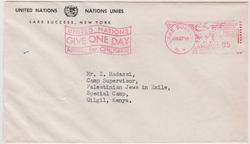 Kenya.UN to Gilgil.arrived 23 MarchMailed from the U.N. at Lake Success, NY to Camp Gilgil. Addressed to Z. Hadassi camp Supervisor. Postmarked 23 January 1948 it arrived 23 March! It was likely a reply to a letter Hadassi sent describing the plight of internees and asking for intervention on their behalf. |  Kenya.letter TO U.N. from GilgilThe letter, dated 2 January Gilgil, Kenya, is available on line. "... Camp members were detained on mere suspicion...great hardship...families lost sole support...Now that future of Palestine is decided repatriation should be immediate ...end this unjust situation." Yours respectfully, Z. Hadassi Camp supervisor. |
 Kenya.photo.EscapeesThis original photo pictures some of the Gilgil internees. Escapes were repeatedly attempted. Some succeeded by excavating an 80 meter tunnel that reached outside the camp fence. It is inscribed on the back 'Part of the group of 43 that escaped from Kenya'. |  Kenya.Detainees in ExileThis unusual envelope, postmarked Kenya 21 April '48, was sent to Tel Aviv with regular stamps, 1 of Kenya & another of South Africa overprinted Kenya. The return address in clear English reads 'Jewish Political Detainees in Exile'. The addressee 'La'asireinu' (Our Imprisoned) was a group that helped internees and their families. Upon arrival a label was attached overprinted 'Emergency mail for Atlit and Kenya'. Then it was rubber-stamped with the organization's name & the date 14 May 1948! |  Map.Gilgil |
 Africa.map | 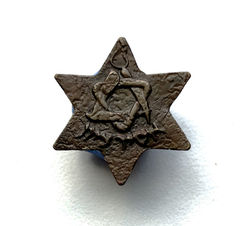 Irgun.pinPin awarded to Betar and Irgun activists who had been interned for their anti-British activities. Already shaped as a Magen David, it also bears tools shaped as a Magen David. The inscription reads 'Asir Tziyon' - a Prisoner of Zion. |  Irgun Captivity MedalIt took years for Israel to honor the Irgunists who had been interned for their efforts at liberation. When Menachem Beigin (a former Irgun leader himself) became Prime Minister (1977-1983), he supported their recognition. They were awarded this medal. Obverse: barbed wire & watchtower and legend 'Symbol of Captivity'. Reverse: the Irgun symbol - a map of 'Greater Palestine' & an arm grasping a rifle. Legend reads 'Only Thus' = it will take armed activism to liberate Israel from British rule. |
 Map.Templer SettlementsBetween 1868 and 1908, German Christians of a sect called 'Templers' established 7 settlements in the Holy Land. Those were agricultural efforts using the newest equipment and techniques. They remained fiercely loyal to their German origins. Industriousness was reflected in farms and homes. 'German Colony' remains a district in Jerusalem and Haifa. |  Templers.Waldheim.Camp 2Naziism came to the Templers of Palestine with the rise of Hitler. There were branches of the party and even Hitler youth. The British created internment camps in 4 of their settlements. Waldheim was designated camp #2. This envelope went from there to a Jewish lawyer in Haifa in August 1944. It is unclear why there is no 'Camp #1'. |  Templers.Bethlehem.Camp 3Bethlehem of Galilee near Haifa was another settlement turned into an internment camp. It was designated #3. Joh. Wagner is also writing to lawyer Jacob Levy in Haifa, who must have handled such cases. The letter was postage-free, came from 'Perimeter Settlement Bait Lehm', was censored twice, and reached Haifa on 20 August 1945. Some 500 Templers were deported to Australia. |
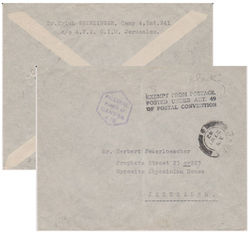 Templers.Jaffa.Camp 4The Templer colony near Jaffa called Sarona was the third to be founded, in 1871. It became internment camp #4. It held nearly 1000 persons, guarded behind a barbed-wire fence. Some were deported to Australia and some others were moved to Camp Wilhelma. |  Templers.Wilhelma.Camp 5Wilhelma, founded in 1902 not far from Jaffa, was camp #5. Most of its residents were transferred to Australia or repatriated to Germqany. Resident Bulach writes to a Jewish man at a pharmacy apparantly owned by his German- Swiss family, on 25 May 1946. A moshav 'Bnei Atarot was established here in 1949. Israel later paid some reparations to the Templers who had lost their land and property in Palestine. |  Interned in Egypt.WWIMany Templers joined German forces in WWI. That made them enemy aliens to the British in Palestine. 850 were interned in Egypt for 3 years. A friend writes to Sanitary Council member Mrs. Einsler on P.O.W. staionery from Helouan Egypt to Jerusalem in May 1919. |
 Interned in Egypt.WWI.b | 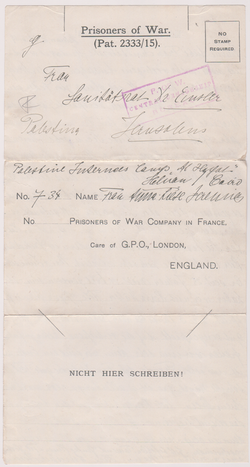 Intern.Templar.WWI.June.A.01Another letter to Mrs. Einsler, from Helouan, Cairo dated June 1919, on P.O.W. stationery. | 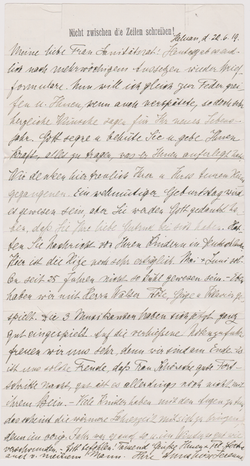 Intern.Templar.WWI.June.B |
 intern.map_edited |  Mazraa.map.this one |
bottom of page